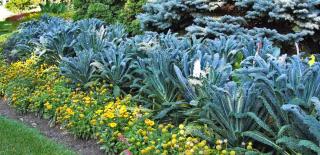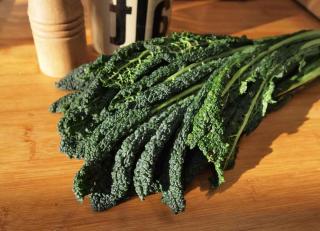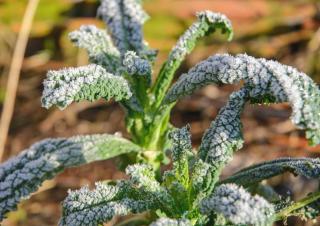

Easy to grow, lacinato kale is also a tasty vegetable to cook with.
Palm tree kale key facts
Botanical name – Brassica oleracea acephala ‘Nero di Toscana’
Common name – Black Toscana, palm tree kale, dinosaur kale, black kale, palm tree kale
Family – Brassicaceae
Type – leaf vegetable
Height – 1½ foot (90cm)
Planting distance – 25 inches (50 cm)
Exposure – full sun
Soil – chalky, loaded with humus
Sowing – March, April
Harvest – from July to November
Thanks to its palm-tree like bearing, its dark green, nearly black leaves, and how easy it is to grow, the ‘Nero di Toscana’ black palm tree kale has earned the right to a spot in your garden. You choose: shall it be in a flower bed as a perennial, or in the vegetable patch as a winter crop?
 Just like the other types of cabbage, the ‘Black Tuscany’ needs soft, loose soil that’s been tilled very deep. You’ll also have to amend the soil with soil mix, compost or manure, but if using manure, make sure it’s very ripe.
Just like the other types of cabbage, the ‘Black Tuscany’ needs soft, loose soil that’s been tilled very deep. You’ll also have to amend the soil with soil mix, compost or manure, but if using manure, make sure it’s very ripe.
Two steps to plant your palm tree kale, and you can only start it from seed:
 The ‘Nero di Toscana’ palm cabbage requires virtually no care at all. All you’ve got to do is make sure the soil stays moist, especially over the summer.
The ‘Nero di Toscana’ palm cabbage requires virtually no care at all. All you’ve got to do is make sure the soil stays moist, especially over the summer.
Smart and eco-friendly tip: starting in June, to reduce the need to water and weed, spread your lawn clippings in thin layers of mulch. This will increase soil moisture. Very important: don’t layer the trimmings too thick, or they’ll start to rot instead, bringing on a number of fungal diseases your kale will have to battle.
 Pick the outer leaves whenever you plan on cooking with them. Repeat every time you need more. Start from the lower, outer leaves and climb your way up. Note that the first bouts of freezing will soften the leaves and make them tastier.
Pick the outer leaves whenever you plan on cooking with them. Repeat every time you need more. Start from the lower, outer leaves and climb your way up. Note that the first bouts of freezing will soften the leaves and make them tastier.
After picking, leaves will keep for a few days in the refrigerator. However, vitamins disappear within the first few hours, so best eat the leaves right after picking them.
 You can also go ahead and freeze palm kale after harvesting them. As a preliminary step, “blanch” the leaves first by dipping them in boiling salt water for 3 minutes. Block the cooking after that: rinse them in cold tap water, and then freeze.
You can also go ahead and freeze palm kale after harvesting them. As a preliminary step, “blanch” the leaves first by dipping them in boiling salt water for 3 minutes. Block the cooking after that: rinse them in cold tap water, and then freeze.
Lacinato kale resists diseases and pests very well. However, it will fall victim to slugs and snails when still at a young stage (seedlings).
Sadly, its worst enemy is the ever-present large white, a cute white moth – but its caterpillars wreck devastation if left unchecked in the vegetable patch.